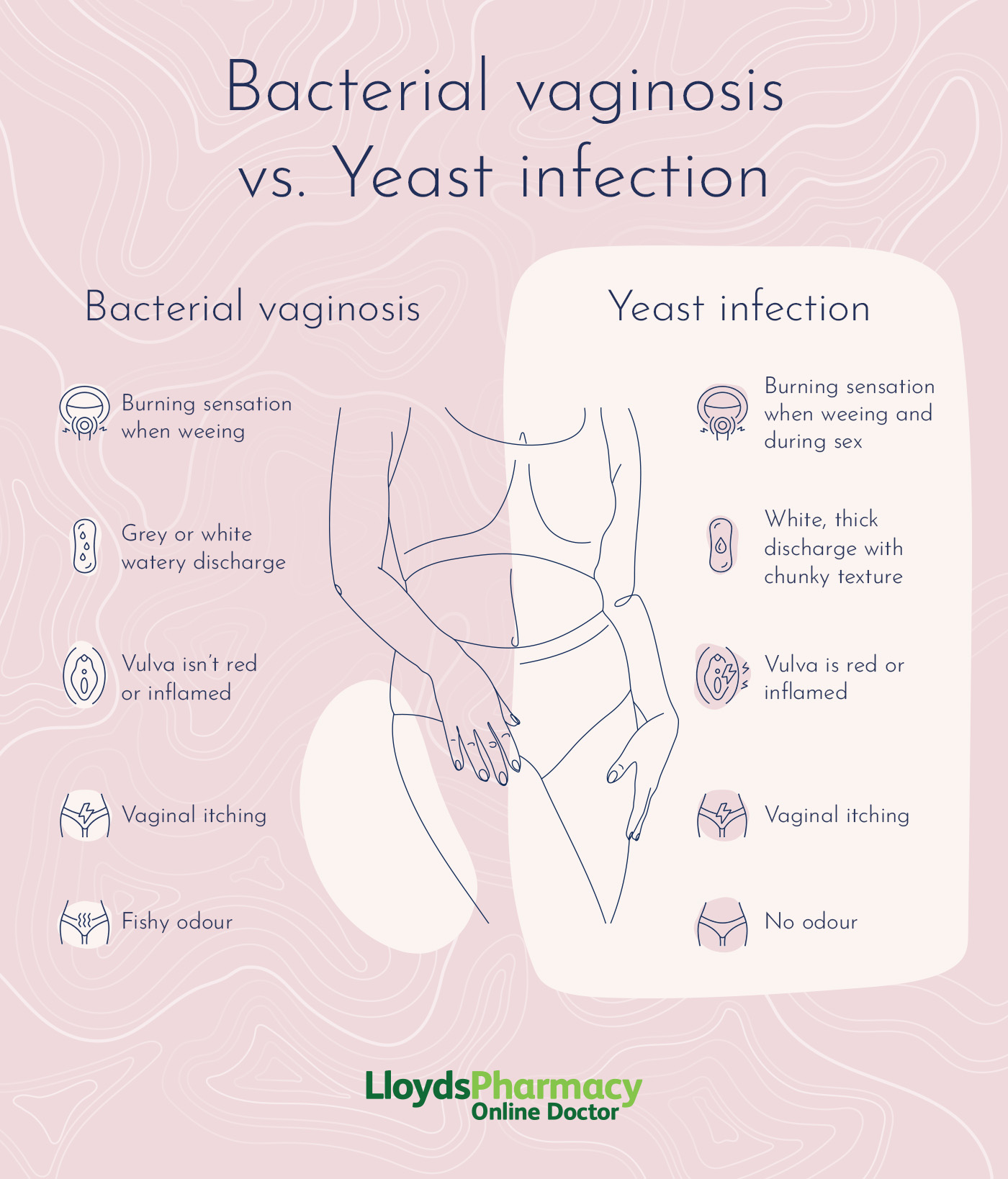Yeast infection vs BV: Causes, symptoms and treatment
Reviewed by our clinical team
If you’re experiencing itching and discomfort in and around your vagina, it can be hard to know if you’ve got a yeast infection or bacterial vaginosis (BV). Learning what’s normal for you when it comes to vaginal discharge and the look and feel of your vulva and vagina, will make it easier to spot when things aren’t quite right.
In this article we’ll explore the symptoms, causes and treatment of yeast infections and bacterial vaginosis.
Are BV and yeast infections the same?
BV and yeast infections are common vaginal problems, that many women experience. Although similar, these vaginal infections aren’t completely the same. They’re caused by different organisms:
- BV is caused by an overgrowth of bacteria in the vagina
- Yeast infections are caused by an overgrowth of the fungus Candida
While symptoms might overlap, the causes of BV and yeast infections are different. So, they need different treatments. If you think you might have BV, or a yeast infection speak to your GP for more advice.
Difference between BV and yeast infections
The main differences between BV and yeast infections are the symptoms you experience. As our table below shows:

Difference between thrush and BV
Bacterial vaginosis is caused by bacteria whereas a yeast infection like thrush is caused by a fungus. Thrush is often used to specific type of yeast infection that occurs in the vagina, mouth and throat. Thrush is commonly caused by the fungus Candida albicans.
Bacterial vaginosis vs yeast infection symptoms
Symptoms can vary from person to person. You might experience a combination of symptoms. If you think you have a vaginal infection you should speak to your GP, as the treatment for BV and yeast infections is different.
BV symptoms
- Thin, greyish-white or white discharge
- Vaginal discharge which has a fishy odour
- You may have itching or burning sensation in the vaginal area
- Pain or discomfort when you wee or have sex
- Typically, no redness or swelling of the vaginal area
Yeast infection symptoms
- Thick, white, lumpy vaginal discharge
- Odourless discharge
- Intense itching and burning in the vaginal and vulvar area
- Redness and swelling in the vagina and around the vulva
- Pain or discomfort when weeing or having sex
BV causes
BV is a common problem, which is caused by an imbalance of the “good” and “bad” bacteria in your vagina. You can increase your risk of developing BV by:
- Not using condoms
- Having multiple sexual partners
- Douching
- Smoking
Yeast infection causes
Yeast fungus like Candida albicans live on our skin. Usually, they don’t cause us any issues. Sometimes there can be too much yeast on our skin which can cause symptoms. Your risk of developing a yeast infection increases:
- Your skin is damaged or irritated
- You use perfumed products, bubble bath or vaginal washes
- You’ve recently had antibiotics
- You’re pregnant
- You have a weakened immune system
BV treatment
BV is typically treated with antibiotics. These could be gels, tablets or creams. The right treatment will depend on how severe your symptoms are. Treatments can include:
- Metronidazole tablet or gel
- Cindamycin cream or tablet
- Tinidazol tablet
Your GP will be able to diagnose your symptoms, so you may find you need an STI treatment instead of BV, as symptoms are similar.
Yeast infection treatment
Yeast infections can usually be treated with antifungal medications. In the form of pills, cream, suppositories and ointments. These are available over the counter or by prescription and can include:
- Miconazole
- Terconazole
- Fluconazole
If your symptoms are severe your doctor may recommend a longer course of treatment.
Which one is worse BV or yeast infection?
Both bacterial vaginosis (BV) and yeast infections can cause discomfort, however neither is “worse” than the other. Getting the right treatment quickly will help clear up any symptoms. If left untreated, both conditions can lead to complications.
If you think you have a vaginal infection, you should speak to your GP. Especially if this is the first time you are experiencing symptoms or you’re unsure whether you have an STI. They’ll be able to diagnose you and offer the right treatment.
Conclusion
Your vagina is self-cleaning and has a delicate pH balance. Using scented soaps, vaginal washes among other things can disrupt this balance leading to infections. BV and yeast infections have distinct symptoms, causes and treatments. Speaking to a GP can help you know which condition you’re experiencing. You may even need to do an STI test to make sure your symptoms aren’t caused by an STI instead.
References
https://www.nhs.uk/conditions/bacterial-vaginosis/
https://www.nhs.uk/pregnancy/related-conditions/common-symptoms/thrush/
https://www.nhs.uk/conditions/thrush-in-men-and-women/
https://www.nhsinform.scot/illnesses-and-conditions/sexual-and-reproductive/bacterial-vaginosis





